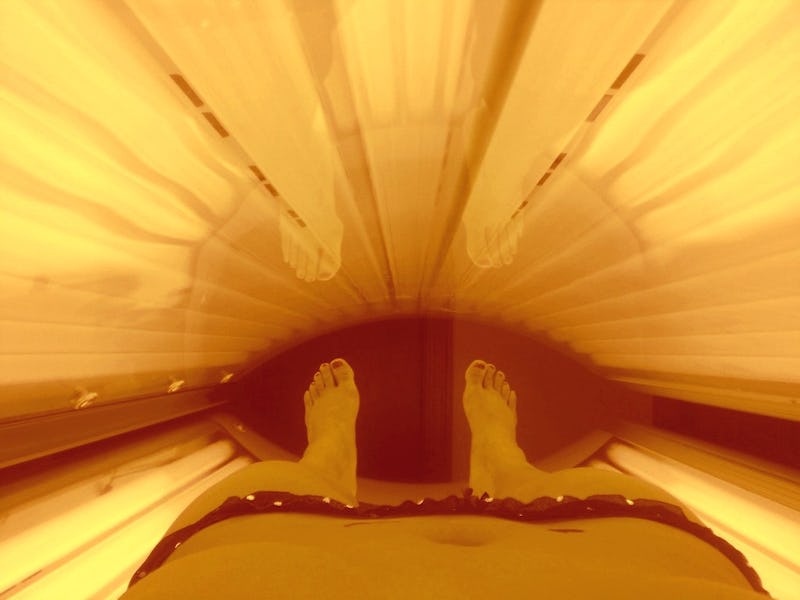Indoor Tanning Enthusiasts Are Showing Signs of "Addiction" in Their Genes
"Indoor tanning has the potential to become an addiction for some people."

In the cold winter months, sun-starved people may be drawn to UV tanning beds like a moth to a lamp. But some scientists are particularly concerned for those who find it impossible to quit getting fried in a coffin-like apparatus. New research in the Annals of Behavioral Medicine suggests indoor tanning may be an addiction, complete with its own genetic signatures.
Overall, an estimated 7.8 million women and 1.9 million adult men tan indoors, but for some, the occasional indoor tanning session spirals into a pattern. A new study highlights two single nucleotide polymorphisms (SNPs), a change in a nucleotide of DNA, that were more common in women who tanned compulsively.
"In the published research there is growing evidence that indoor tanning has the potential to become an addiction for some people."
That pattern, first author Darren Mays, Ph.D., an associate professor of oncology at Georgetown University Medical Center, tells Inverse, may one day be classified as addictive. This latest work builds on his 2017 study, which found that out of 389 women, 22.6 percent compulsively tanned in a way that was reminiscent of other, more familiar addictions.
In the new paper, Mays examined a group of 292 women and found changes on a gene called DRD2, a dopamine receptor gene. Because of the role that dopamine plays in the brain’s reward system, he argues that his results point to a “reward-based model for indoor tanning addiction” that keeps people coming back for more.
“In the published research there is growing evidence that indoor tanning has the potential to become an addiction for some people,” he tells Inverse. “Our study adds to this research by showing that variation in genes in the dopamine system, a neurotransmitter that is central to a number of addictive behaviors, is associated with tanning addiction.”
Mays identified two single nucleotide polymorphisms that were more common in women who had an addiction-like relationship with indoor tanning.
Twenty-two percent of the women in Mays’ latest group “screened positive for an indoor tanning addiction.” And among these women, he found two common SNPs. Overall, someone with one of these tiny changes had 2.3 times higher odds of being addicted to indoor tanning. Someone with the other variant was 1.9 times more likely to screen positive for indoor tanning addiction.
As it stands, indoor tanning isn’t a recognized addiction in the Diagnostic and Statistical Manual of Mental Disorders, a guide to all diagnoses that’s maintained by the American Psychiatric Association. The only behavioral addiction that’s recognized as a “diagnosable condition” by the DSM-5 is gambling addiction, though internet gaming is mentioned in an additional section and is now recognized by the World Health Organization. But that move has taken time, and it’s sparked plenty of controversy.
Like other behavioral addictions, indoor tanning will also need a serious evidence base if it’s ever going to be recognized in WHO or APA documents. But Mays is hopeful that his study will help push the idea forward, especially as we find out what factors might make indoor tanning such a hard habit for some to break. Interestingly, Mays explains that he’s already starting to identify some additional factors that seem to be associated with this behavior, most notably depressive symptoms.
“In our previous work and research by others, we observed that young women with elevated depressive symptoms are more likely to meet criteria by which we define tanning addiction,” he says.
In his study, he found that women who had one of the two SNPs he identified and reported depressive symptoms had even higher odds of reporting addictive-like tanning behavior. Women with one DRD2 variant and depressive symptoms had 10 times higher odds of having an addictive relationship with tanning.
Mays, who specializes in the behavioral aspects of cancer prevention, isn’t only interested in indoor tanning addiction because it seems strange. He’s particularly interested because of the role that indoor tanning may play in elevating cancer risk. Right now the, the American Academy of Dermatology says that indoor tanning is associated with increased risks of melanoma and other forms of skin cancer.
Mays also adds that the connection between indoor tanning and cancer is “well established” and “especially important for young people.” If tanning really is an addiction, then he argues that we may need more resources to help people manage it, especially in light of cancer risk.
“By gaining a better understanding of indoor tanning addiction and developing interventions to help people quit, we can make progress to prevent and reduce skin cancer in this population.”
Partial Abstract:
Methods: This was a cross-sectional study with a community sample of 292 non-Hispanic white young adult women aged 18–30 years who reported indoor tanning in the past year. Self-report measures included indoor tanning frequency, appearance orientation, depressive symptoms, and two screeners of tanning addiction. DNA samples were analyzed for 34 single nucleotide polymorphisms (SNPs) in candidate genes in addiction reward pathways.
Results: No SNPs were significantly associated with tanning addiction in univariate analyses after multiplicity adjustment. In multivariable analyses adjusting for indoor tanning frequency, appearance orientation, and depressive symptoms, variant genotypes (CC or CT) in two DRD2 dopamine receptor gene SNPs were associated with increased odds of indoor tanning addiction (rs4436578, odds ratio [OR]: 2.30, 95% confidence interval [CI]: 1.11–4.77; rs4648318, OR: 1.95, 95% CI: 1.02–3.72). Variant SNP genotypes interacted with depressive symptoms to increase the risk of indoor tanning addiction: OR: 10.79, 95% CI: 3.25, 35.80, OR: 13.60, 95% CI: 4.13, 44.78, respectively.
Conclusions: This study provides preliminary evidence that DRD2 dopamine receptor gene SNPs are associated with indoor tanning addiction and young women with variant genotypes and elevated depressive symptoms may be at higher risk. These preliminary results support a reward-based model for indoor tanning addiction and warrant further investigation.